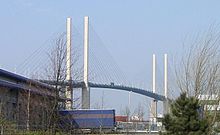Trafalgar House (company)
[1] The entrepreneur Nigel Broackes, who would be the chairman of Trafalgar House throughout much of its existence, played a key role in the company's emergence during the late 1950s and early 1960s.
Broackes worked with the Eastern International Investment Trust and Commercial Union to build a portfolio of assets that would be the initial footings of the company.
Two years later, Broackes formed a relationship with Commercial Union, which also bought shares in EIPI and prepared to act as a financial backer for new property developments.
[3] The existence of a public quotation enabled Trafalgar House to issue shares for acquisition, a facility that Broackes made extensive use for the company to become a formidable international industrial and commercial undertaking.
[4] Both acquisitions and direct investments were primary vehicles used for growth; typical targets of attention were businesses operating in the construction and engineering sectors.
Trafalgar also entered fields that were far removed from its original property development and construction roots with the purchase of Cunard in 1971 and Beaverbrook's Express Newspapers in 1976.
[10][11] In 1980, there was public outcry at the sudden destruction by Trafalgar House of the Art Deco main entrance to the former Firestone tyre factory (designed by Wallis, Gilbert & Partners, 1928–29) in Brentford,[12] which had been torn down over the August bank holiday weekend to (legally) pre-empt and thus nullify an imminent preservation order under the listed buildings legislation.
The company was due to embark on the West Cross Development, an extensive redevelopment of the large industrial site, which would have been seriously hampered by a requirement to maintain both the lengthy architectural facade of the old factory and its broad approach sightlines and boundary features.
[15][16] In 1995, it bought the bomb-damaged site of the historic Baltic Exchange building, at 30 St Mary Axe in London, which had been severely damaged when the Provisional Irish Republican Army detonated a bomb nearby on 10 April 1992.
[17] During 1998, the site was resold, with planning permission, for £81 million to Swiss Re, who commissioned and occupied the renowned Gherkin building, designed by Foster + Partners.
From then on the prime umbrella operating division, in terms of turnover and revenue, was Trafalgar House Construction; generally referred to both inside the company and within the industry as 'THC'.
[1][3] In 1986, Trafalgar House acquired John Brown Engineering, which built industrial gas turbines and also implemented licensed processes, such as the Union Carbide Corporation Polyethylene Plant.
The basic processes were engineered to fit the purchaser's requirements, including the site plan, the production capacity, the raw material feedstock, and other constraints.
[25][26] In 1992, Trafalgar House acquired the Davy Corporation, a group of international engineering companies which also included a well-established UK wide construction division, in exchange for £114 million.

Queen Elizabeth II Bridge over the River Thames at Dartford

THC were appointed head of the construction consortium in 1995 and were awarded twenty-six percent of the work on this 17 kilometre elevated roadway structure.